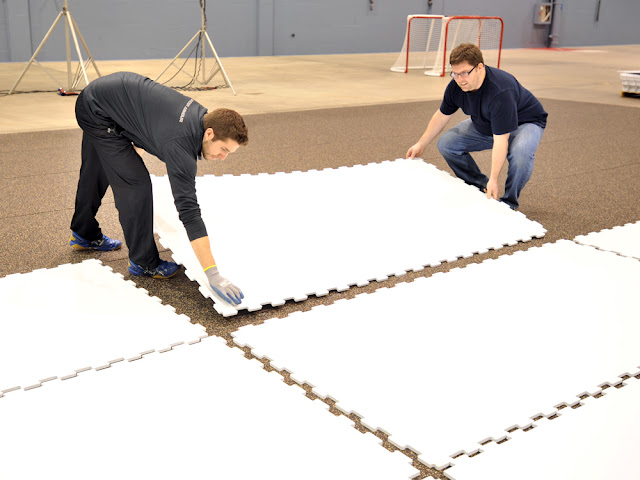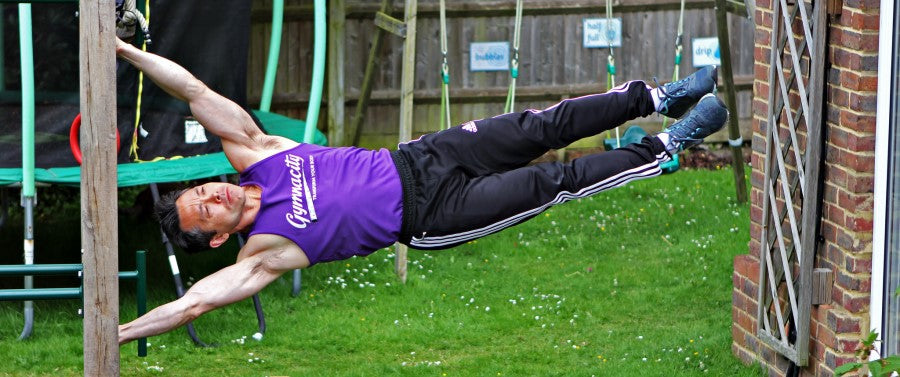
What’s the Difference Between Slick Tiles and Synthetic Ice?
When deciding how to set up your own personal skating rink at your home, you have more than a few options to think of. From the type of tiles that you use to if you want to decorate it, how you want to decorate it, the list goes on. The part that most people get hung up on is slick tiles vs synthetic ice. There are a lot of differences between these two products which makes this entire process more than a little tricky, especially if you’re just in the research phase of your purchase.
It doesn’t have to be too difficult though. It takes a bit of thought and considering exactly what will best benefit your situation, but you can pick the best option for you with relative ease. Today we’re going to be looking at slick tiles, otherwise known as hockey flooring and dryland hockey tiles, as well as synthetic ice, which is also known as artificial ice but that name is less commonly used because it can lead to some confusion. We’re going to do our best to help you decide which one is going to work the best for your situation so you can move forward with confidence.
Good Arguments for Using Dryland Hockey Tiles
There are two camps on this topic, as you might have imagined considering that we’re looking at two products. Each camp makes good points, but keep in mind that ultimately the one that you go with depends entirely on your needs and spatial restrictions. Fortunately, the positives and negatives of both dryland hockey tiles and synthetic ice are incredibly well known. Looking at the dryland hockey tiles, it’s clear why someone might choose them over the synthetic ice in a variety of situations.
The biggest positive that dryland hockey tiles have over synthetic ice is that you can leave them up and walk on them with ease. Now, you’re supposed to practice on the hockey tiles in your shoes or socks, which means that you’ll need to be a little cautious when walking on them, but other than that you’ll face little to no issue. That means that if you want to set it up in your backyard you can and you won’t even have to take it down when you host an event in your backyard, granted you warn your guests about the potential hazard so they know to be careful.
The tiles are also weather-proof which means that setting up the dryland hockey tiles in your backyard is even more of a viable choice. Now, what if you want to set them up in your garage? Is that going to cause much of an issue? The answer here is no. We already know about the tiles being safe enough to leave up at events, so long as the people walking on it are watching their step, which translates to being able to walk from your car to the inside of your house pretty easily.

On top of that, most dryland hockey tiles are also designed to be able to handle a lot of weight. That means that you can park your cars on top of it and face little to no issue other than any fluids that your car might be leaking. If your car is leaking, that will likely mean that you just need to clean the tiles a little more often than you would otherwise. That’s not too big of a deal for the most part, especially if you already have the proper tools to get the spills cleaned up correctly.
Now that we’ve covered how easy it is to place the dryland hockey tiles, let’s look at what you can actually do using the tiles. You can get a lot of solid training in by using these tiles. Realistically, you can run any drill on these tiles that you would on ice that doesn’t involve using your ice skates. That’s because you can’t use your ice skates on dryland hockey tiles, but you can use your socks or shoes. With that in mind, you can still hit the puck around and expect to get a similar feeling to hitting the puck on real ice, and that’s incredibly useful for getting in good training.
Arguments for the use of Synthetic Ice
Now that we’ve looked at the reasons why people seem to love dryland hockey tiles, let’s look at the reasons why people like synthetic ice so much. Before we delve too deep into this section, we felt it was important to let you know that synthetic ice isn’t made up of water. In most cases, this product is made up of some sort of plastic product. The most commonly used plastics for this are high-density polyethylene and ultra-high-molecular-weight polyethylene, solely because these two materials are able to give a good glide factor.
Synthetic ice is a surface that you can use your real ice skates on, which makes them a great choice for people that are looking to get some practice while wearing their skates. The biggest issue with synthetic ice in this category is that it does dull your blades at about twice the rate that real ice does, but that can be easily remedied by just learning how to sharpen your own blades so you don’t have to spend a small fortune at the blade sharpener’s shop. You could even sharpen your own blades for practice and have a professional do it when you have a big game coming up to make sure that it’s done flawlessly.
Now, as far as placing your synthetic ice, you may run into a few more challenges. While it is just as weather-proof as dryland hockey tiles and synthetic ice can typically handle the same load, you don’t want to put it anywhere that has a lot of foot traffic. That’s because synthetic ice is very slick. In fact, synthetic ice is far slicker than dryland hockey tiles and that’s by design.
If you just walk on the synthetic ice while wearing your regular shoes, you wouldn’t really be able to tell the difference between it and real ice. That means that it might not be the ideal choice to just set up it in your garage and park on it unless you really trust yourself to have good enough balance to handle it on a daily basis. You also might need to either tear it down or cordon off that section of your backyard if you have guests over for any reason. That’s just to be on the safe side.
Now, synthetic ice does have many benefits. You can run literally any drill on synthetic ice that you would on real ice, making it a great tool for your practice. Unlike true ice, synthetic ice doesn’t melt so you can use it no matter what season it is. That means that you can be getting in ice skating practice in the middle of July without any worry about the surface beneath you melting. That’s an invaluable experience for hockey players, especially people that don’t want to lose even an iota of skill during the warmer months while they wait for the game season to come back around.
Which is the Better Choice?
It can be hard to choose what is best, even with all of the information right in front of you. Unfortunately, we can’t make that choice for you simply because we don’t know your situation. We do have some generalizations that can help you a bit, but at the end of the day you know what’s going to work best for your household and you can figure out what will be the best fit for your practice time, whether you’re the one that needs to practice or it’s someone else in your home.
Generally, if you don’t have a lot of space to work with and don’t mind not getting on the ice training, we’d recommend the dryland hockey tiles. These tiles are good at conforming to the space that you need to fill while also giving you a chance to drill your stickhandling skills. If you aren’t as concerned about space as you are with your skills on the ice, synthetic ice will generally be the better choice because you can use your real ice skates on it without any issue. As we said, these are just generalizations so you’ll still have to think about your needs and space.
Get the Most out of Your Training Year-Round
Many hockey players struggle to get good practice in during most of the year. It makes sense, most months don’t get cold enough to form the ice that is needed to get some practice in. Fortunately, due to technological advancements over the years, it’s gotten easier and easier to get some high-quality practice in no matter how warm or cold it might be outside at the moment. Choosing the right product for your training regimen for you can produce results that you never thought were possible.


